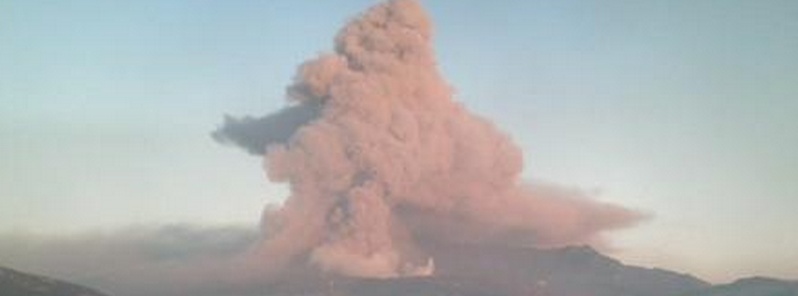New eruption of Asosan volcano, Japan

Japanese Asosan volcano experienced a new eruption at 01:33 UTC on December 23, 2014. Tokyo VAAC reported volcanic ash cloud reached an altitude of 2.1 km (7 000 feet) and extended East. At 06:11 UTC it rose to approximately 2.3 km (8 000 feet) and was still extending East.
Asosan is a famous volcano for its largest caldera in the world. It is located at the center of Kyushu, Japan, about 1 000 km WSW of Tokyo. More than 10 volcanic cones are distributed in the large caldera of 25 km in diameter. Among these, Nakadake frequently erupted in the form of Strombolian eruption within recorded history causing casualties in some cases, JMA explains.
Recently, JMA reported that, based on seismicity and infrasound data, the eruption from Asosan’s Nakadake Crater that began on November 25, 2014 continued during December 8 – 12; but inclement weather often prevented observations of the crater. A webcam recorded tephra being carried by high winds and deposited in an area 1 km W.
During a field survey on December 10 volcanologists observed 20-cm-wide blocks near the crater and 5-10-cm-wide blocks within 1.2 km SW of the crater. Plumes rose 600 m above the crater and incandescent material was sometimes ejected onto the crater rim. During December 12 – 15 the plume rose 1 km above the crater rim. Ashfall was reported E in Hanoi Aso (Kumamoto Region). Incandescent material was occasionally ejected onto the crater rim.
The Alert Level remains at 2 (on a scale of 1-5).
#volcan #volcano #Aso les émissions de cendres reprennent de plus belles/renewed ash emissions pic.twitter.com/b1e1iUJNHW
— CultureVolcan (@CultureVolcan) December 23, 2014
Geologic summary
The 24-km-wide Asosan caldera was formed during four major explosive eruptions from 300,000 to 90,000 years ago. These produced voluminous pyroclastic flows that covered much of Kyushu. The last of these, the Aso-4 eruption, produced more than 600 cu km of airfall tephra and pyroclastic-flow deposits. A group of 17 central cones was constructed in the middle of the caldera, one of which, Nakadake, is one of Japan's most active volcanoes. It was the location of Japan's first documented historical eruption in 553 AD.
The Nakadake complex has remained active throughout the Holocene. Several other cones have been active during the Holocene, including the Kometsuka scoria cone as recently as about 210 CE. Historical eruptions have largely consisted of basaltic to basaltic-andesite ash emission with periodic strombolian and phreatomagmatic activity. The summit crater of Nakadake is accessible by toll road and cable car, and is one of Kyushu's most popular tourist destinations.
Featured image: Asosan eruption on December 23, 2014. Credit: Kumamoto University webcam.

This Vedic astrology writer’s predictions were published in Summer 2015 ( April-June 2015) issue of The Astrologer’s Notebook, a print quarterly Newsletter from North Port , Florida. The article – ” Total lunar eclipse of 28 September 2015 and world” – carried this prediction : – “countries such as Japan could be in focus. Though second half of 2015 seems to be causing concern , months October and November of 2015 are likely to trigger unwelcome things out of above mentioned aspects or areas of concern. Some islands located near sea may need to take precaution”. The concerns or focus could relate to circumstances which have something to do with ” eye sight” or “respiratory system” and ” earthquake”. Briefly speaking, these seem to point to volcano eruption. The reported warnings of likely volcano eruption in news suggest that Japan is in focus for volcano eruption, proving accuracy of this writer’s prediction.
It may be made clear here that planetary impacts suggesting likely trends are indicative only and not deterministic meaning that pre-emptive measures or precautions has a tendency to either soften the outcome of impacts or sometimes escape the happening with God’s grace.